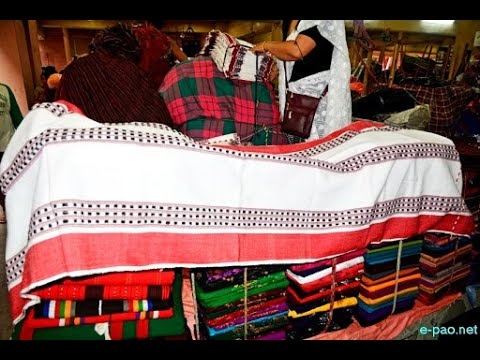
By N. Munal Meitei
Now-a-days, there has been many claims of Manipuri Leirum being manufactured and sold allover the country as a popular fashion in the brand name of Modi Scarfs. The matter is discussed widely among the intricacies. Such is really a big point of objectionable. Getting UNESCO recognition on our Nat Sankritan and also bagging Geographical Indication (GI) tag for Manipur Chakhao, Safi-Lanphi, Moirangphi and Wangkhei phi have something mental relives to our pastimes. But a lot more like the Umanglai Haraoba which being the greatest single key and original source for all our cultural, historical and traditional value of the Meitei and other associated tribes are still yet to be streamlined. The same is the fate for Ngari, Soibum, Hawaijara, Eronba, Singju, Kakching Bora etc. etc.
Manipur is famous for its special fabrics like the moiraingphee, leirum and phanek mayek naibi etc. Earlier weaving was universal and every girl knows how to weave. The loom forms were the part of their lives. There was an aura of religion and romance on weaving,highlighting with every legend and connected to the ceremonies. Ningthou phi,akoibiphi and samilami phee have the motifs and the designs of well fabrication. In our culture, maximum of lucrative designs are found on the phaneks worn by women because they are the primary producers.
Manipur is said to be the original home of the mulberry silk worm, and it is said that it went from here to China. Its own art-forms and cultural expressions and ramifications distinctly showcase the state to the World. Its famous classical dance remains unique in all dance forms whether it’s folk, classical or modern and has a different style and gesture of movement. Manipur is are artistic and creative by nature. This has found expression and big images in their handloom and handicraft products also. Our handloom and handicraft are world-famous for their designs, ingenuity, colorfulness and usefulness.
Since time immemorial, the Meiteis have used different types of clothes having unique ceremonial values. The Leirum phi which was used by our P.M. Modiji is smaller size of Leirum phi used as lengyan. In our original, Leirum phi is traditionally big and coarse shawl used as wrappers, but with a peculiar woven design. It has been an indispensable item of gift given by parents to their daughter on her marriage ceremony.
The story of the evolution of the Leirum phi can be traced back to the reign of Khui Tompok(154- 264),the Meitei king of Manipur. As recorded in the Cheitharol Kumbaba,on the occasion of the marriage of Nongmoinu Ahongbi, an Angom princess to Khui Tompok, the parents of Nongmoinu Ahongbi presented her a Leirum cloth as her wedding gift. It is believed, since then, it has become a tradition to gift leirum cloth in the Meitei marriage.
There is another reference of the Leirum cloth which claimed to be given as gift by a Tangkhul King during the marriage of his daughter, goddess Ireima to King Irengba (984-1074). There are many stories associated with the Leirum cloth and many communities have different versions which need an extensive research and findings. As time passed, the designs on this cloth changes from the original design of Leirum that survived among the Tangkhul Naga tribes of Manipur. Thus, the Leirum Phi also signifies the unity in diversity among the communities. The Leirum phi also symbolize the purity, strength, trust and unity of life.
On 15th August, 2019, the Honble Prime Minister Narendra Modi used the leirum lengyan while on addressing the nation from the Red Fort. On 14th April 2020, Prime Minister again wore the leirum lengyan while on announcing for 2nd phase of lockdown over the deadly COVID-19 pandemic. And many more occasions also, the Hon’ble P.M. used the Manipuri Leirum Lenyan phi.
On seeing repeatedly, the Hon’ble Prime Minister Modiji with a familiar but a distinctly colourful scarf, people started to ask about the cloth and search the origins of the cloth. Latter, people realized the cloth is the Leirum Phi, a traditional religious cloth of Manipur.
This Manipuri traditional cloth, the Leirum Phi is commonly made from cotton fabric designed by using three colours; black, red proportionately designed onthe larger white clothes, signifying the three guardians of the Universe, the Khuman, Mangang and Luwang respectively. All the Meitei clans (sageis)are originated from these three Gods. Therefore the Leirum phi is the symbol of oneness, peace, stability, power, might and belongingness.
Leirum Phi is also use while honoring the dignitaries and in functions. John Keats once said, beauty is joy forever.Now, the beauty of Leirum has invited and evoked the hearts of every Indians which again has enhanced the proud for Manipur signifying our rich culture and traditions.The long fascinated tales hiding behind in its every tread will always retold the aged history of love and romance to everyone to come by.
Now, we should immediately go for Intellectual Property rights or G.I tag for our Leirum to provide the rights through patents, copyrights and trademarks. These legal systems will safeguard our rights of monopoly on protection of Leirum phi forever for Manipur. Therefore, we cannot allow anyone to copy and steal our age old cultural and traditional emblem, the Manipuri Leirum phi which long been embedded rich inside our cultural legacy.



